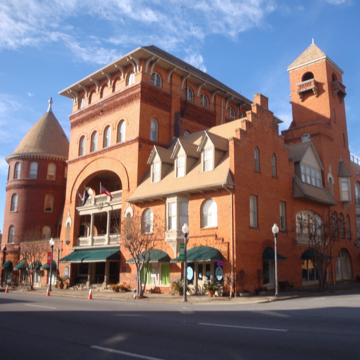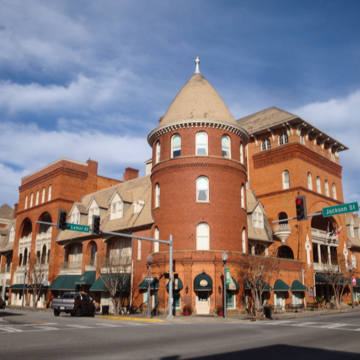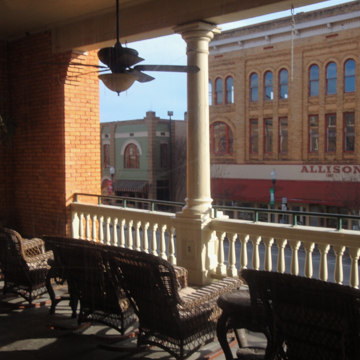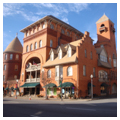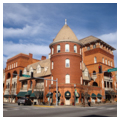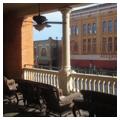Driving into the southwestern city of Americus, passing through a rural landscape of peach orchards, pecan groves, and cotton fields, one may be surprised to see the looming tower and roofline of the Windsor Hotel. The vision calls to mind the skyline of Blois in the Loire Valley, where late-Gothic crocketed gables and roof peaks tower picturesquely against the sky. Architect Gottfried Norrman no doubt imagined such romantic silhouettes and powerful forms when he competed for this commission with Atlanta architect W. H. Parkins, offering a proposal which Norrman intentionally gave “more fanciful character” than Parkins’s proposed four-story, square wooden building of 120 rooms. Norrman claimed his hotel would rival Carrère and Hastings’s 1888 Hotel Alcazar in St. Augustine, Florida. His winning proposal for a three- and five-story brick extravaganza with 100 hotel rooms and ten street-level stores was originally to be called The Alhambra. The hotel’s three-story atrium of golden oak columns and arches indeed displays some Moorish details—the arches themselves, the wrought-iron railings, the geometric patterns in the oak and marble flooring, and the hand-carved floral patterns in the balustrades. Ultimately, the hotel was named for John Windsor (1847–1930), a local businessman and investor in the hotel, with the possible secondary benefit that tourists—especially those escaping northern winters—might associate the name with the House of Windsor in England.
Balconies, windows of varied sizes and character, upper verandas, a massive round corner tower, latticework, stepped gables, a secondary tower, bracketed roof overhangs, varied dormers, and rich juxtapositions of brick, terra-cotta, and stone and wood trim all enrich the composition of this late-Victorian edifice; it is a combination of powerful masonry, dramatic forms, and constructional and decorative surface richness. Estimated at $80,000, the final cost was over $150,000 by the time of its completion. It was built by James Smith of Sparta, Georgia, a contractor who had erected Norrman’s city hall in Americus and who executed improvements to one of Americus’s two public schools, the former Furlow Masonic Female College, also by Norrman. A local brickyard supplied the building materials, and construction took thirteen months (September 1891–October 1892). The Americus Furniture Company was originally contracted to furnish the hotel but M. Rich and Brothers of Atlanta (later founders of Rich’s Department Store) took over. The grand opening took place in June 1892, with a grand ball held in the fifth-floor hotel ballroom.
Trouble followed almost immediately due to the Panic of 1893. The economic depression affected the tourist trade on which the Windsor was so reliant. By the end of the decade the hotel declared bankruptcy. The building was bought at a public sale in 1899 by a local jeweler who paid a mere $40,000. A decade later, in 1910, the building was modernized with electric lighting, new elevators, telephones, and steam heat. By the 1930s the hotel had not regained its original Victorian splendor and was sold again to an hotelier from Florida, Howard Dayton, whose family eventually gave the hotel to the city of Americus in 1978. By this time, the grand hotel had become Americus’s downtown “white elephant.”
Faced with possible demolition, the community overwhelmingly favored restoration so that the grand hotel might become the catalyst and centerpiece of a broader downtown revitalization. Georgia preservationists were still mourning the loss of Savannah’s Hotel DeSoto (1888–1890, William Preston) in 1966 and many Americus residents did not want to make a similar mistake and raze the state’s finest surviving late Victorian hotel. The city secured public grants and private investments over the next decade in order to save the Windsor: a 1978 grant from the Georgia State Historic Preservation Office funded a preservation plan; another grant in 1979 secured the hotel’s stabilization and paid for necessary masonry work; a grant for roof repairs in 1983 was followed by interior renovation work that utilized inmate labor; a 1984 city grant funded additional masonry work and painting; and a 1987 Community Development Block Grant paid for the replacement of the hotel roof and renovation of parts of the hotel as a senior citizen center. Private investments paid for professional services of engineers, architects, and others, and local bank loans and a special property tax were dedicated to the Windsor. A Main Street program project coordinated a broader-based downtown revitalization, and the whole of Americus began to take pride in civic improvements to which they all had contributed, especially the rebirth of the Windsor.
A major renovation of the hotel took place from October 1990 to September 1991, and the Windsor reopened on September 20, 1991. A second extensive upgrade took place in 2010, which added recreational, business, and technology improvements to the hotel. The earlier 1991 hotel renovation had reduced the original 100 guests rooms to fifty-three rooms and suites, each with a unique period stylistic decor, twelve-foot ceilings, ceiling fans, and modern amenities.
The original Windsor Hotel hosted numerous famous guests, including labor leader Eugene V. Debs and then New York Governor Franklin Delano Roosevelt. The renovated Windsor was no different: it was former President Jimmy Carter from nearby Plains, Georgia, who helped cut the ribbon during the 2010 grand reopening. Today, inside the round tower, the hotel features the Carter Presidential Suite as well as the Roosevelt Board Room. The third-floor executive suites were named in 1993 for Jessica Tandy and Hume Cronyn, who filmed To Dance with the White Dog in Americus, which was based on the novel by Georgia writer Terry Kay.
Today, the hotel is affiliated with Best Western and is one of the country’s most distinctive late-century hotels still in operation, an eclectic amalgam of Eastlake, Queen Anne, and Neo-Romanesque Victoriana.












